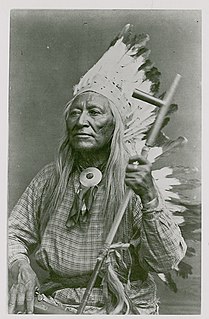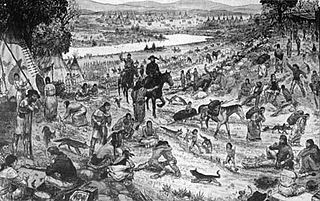
The Oregon Trail is a 2,170-mile (3,490 km) historic east-west, large-wheeled wagon route and emigrant trail in the United States that connected the Missouri River to valleys in Oregon. The eastern part of the Oregon Trail spanned part of the future state of Kansas, and nearly all of what are now the states of Nebraska and Wyoming. The western half of the trail spanned most of the future states of Idaho and Oregon.

Fort Bridger is a census-designated place (CDP) in Uinta County, Wyoming, United States. The population was 345 at the 2010 census. The town takes its name from the eponymous Fort Bridger established in 1842.

A mountain man is an explorer who lives in the wilderness. Mountain men were most common in the North American Rocky Mountains from about 1810 through to the 1880s. They were instrumental in opening up the various Emigrant Trails allowing Americans in the east to settle the new territories of the far west by organized wagon trains traveling over roads explored and in many cases, physically improved by the mountain men and the big fur companies originally to serve the mule train based inland fur trade.

The North Platte River is a major tributary of the Platte River and is approximately 716 miles (1,152 km) long, counting its many curves. In a straight line, it travels about 550 miles (890 km), along its course through the U.S. states of Colorado, Wyoming, and Nebraska.

Washakie was a prominent leader of the Shoshone people during the mid-19th century. He was first mentioned in 1840 in the written record of the American fur trapper, Osborne Russell. In 1851, at the urging of trapper Jim Bridger, Washakie led a band of Shoshones to the council meetings of the Treaty of Fort Laramie (1851). Essentially from that time until his death, he was considered the head of the Eastern Shoshones by the representatives of the United States government. In 1979, he was inducted into the Hall of Great Westerners of the National Cowboy & Western Heritage Museum.
Jim Baker (1818–1898) was a frontiersman, trapper, hunter, fur trader, explorer, army scout, interpreter, soldier, territorial militia officer, rancher, mine owner, toll keeper and mountain man. He was a friend of Jim Bridger and Kit Carson and one of General John C. Fremont's favorite scouts.

Buckskinning is a branch of historical reenactment concentrating on the fur trade with different areas in the period of the Old West. Participants may choose to portray mountain men, American Indians, traders, missionaries, or anybody else who might have been in the Rocky Mountains between 1800-1840.
David Edward Jackson was an American pioneer, trapper, fur trader, and explorer. Born in what is now West Virginia, as a married man he moved with his family to Ste. Genevieve, Missouri, where in 1822 he became a clerk for the William Ashley and Andrew Henry fur trade partnership, based in St. Louis, Missouri joining a major expedition to the upper Missouri River.
The enterprise that eventually came to be known as the Rocky Mountain Fur Company was established in St. Louis, Missouri, in 1822 by William Henry Ashley and Andrew Henry. Among the original employees, known as "Ashley's Hundred," were Jedediah Smith, who went on to take a leading role in the company's operations, and Jim Bridger, who was among those who bought out Smith and his partners in 1830. It was Bridger and his partners who gave the enterprise the name "Rocky Mountain Fur Company."

Jacques La Ramée, was a French-Canadian Métis coureur des bois, frontiersman, trapper, fur trader, hunter, explorer, and mountain man who lived in what is now the U.S. state of Wyoming, having settled there in 1815. His name appears in several spellings, including La Ramee, Laramée, LaRamée, La Ramie, La Rami, La Remy, and Laramie. La Ramée is credited as an early explorer of what is now called the Laramie River of Wyoming and Colorado. The city of Laramie, Wyoming, with an Americanized spelling, was later named for him.

William Lewis Sublette, also spelled Sublett, was an American frontiersman, trapper, fur trader, explorer, and mountain man. With his four brothers, after 1823 he became an agent of the Rocky Mountain Fur Company. Later he became one of the company's co-owners, exploiting the riches of the Oregon Country. He helped settle and improve the best routes for migrants along the Oregon Trail.

Oregon pioneer history (1806–1890) is the period in the history of Oregon Country and Oregon Territory, in the present day state of Oregon and Northwestern United States.
Osborne Russell was a mountain man and politician who helped form the government of the U.S. state of Oregon. He was born in Maine.

Pierre's Hole is a shallow valley in the western United States in eastern Idaho, just west of the Teton Range in Wyoming. At an elevation over 6,000 feet (1,830 m) above sea level, it collects the headwaters of the Teton River, and was a strategic center of the fur trade of the northern Rocky Mountains. The nearby Jackson's Hole area in Wyoming is on the opposite side of the Tetons.
John Henry Weber (1779–1859) was an American fur trader and explorer. Weber was active in the early years of the fur trade, exploring territory in the Rocky Mountains and areas in the current state of Utah. The Weber River, Weber State University, and Weber County, Utah were named for Weber.

Rocky Mountain Rendezvous was an annual gathering (1825–1840) at various locations held by a fur trading company at which trappers and mountain men sold their furs and hides and replenished their supplies. The large fur companies put together teamster driven mule trains which packed in whiskey and supplies into a pre-announced location each spring-summer and set up a trading fair—the rendezvous—and at the season's end, packed furs out, normally the British Companies to Fort Vancouver in the Pacific Northwest, and to one of the northern Missouri River ports such as St. Joseph, Missouri, if an American overland fur trading company.
The Oregon Trail is a historic 2,000-mile (3,264-km) trail used by American pioneers living in the Great Plains in the 19th century. The emigrants traveled by wagon in search of fertile land in Oregon's Willamette Valley.
In North American history, a rendezvous was a larger meeting held typically once per year in the wilderness. All types included a major transfer of furs and goods to be traded for furs. Variations included a mix of other types of trading, business transactions, business meetings and revelry.

The fur trade in Montana was a major period in the area's economic history from about 1800 to the 1850s. It also represents the initial meeting of cultures between indigenous peoples and those of European ancestry. British and Canadian traders approached the area from the north and northeast focusing on trading with the indigenous people, who often did the trapping of beavers and other animals themselves. American traders moved gradually up the Missouri River seeking to beat British and Canadian traders to the profitable Upper Missouri River region.
Henry Fraeb, also called Frapp, was a mountain man, fur trader, and trade post operator of the American West, operating in the present-day states of Colorado, Wyoming, and Montana.












